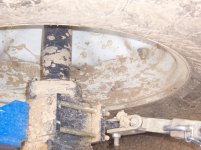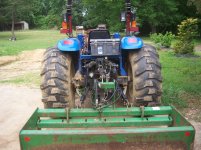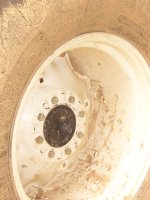Thanks for the details Roto. That setting looks nice on yours. I have a DX55 that just came in and the dealer is adding wheel wts, loader, rear remotes, etc. They needed to know where I wanted the wheels set, and I decided on 56 or 57" center width too, but I have R1's my overall width will be a couple inches narrower than yours.
You are using an out of date browser. It may not display this or other websites correctly.
You should upgrade or use an alternative browser.
You should upgrade or use an alternative browser.
TC55DA tire spacing pictures!!
- Thread starter Roto
- Start date
- Views: 7834
More options
Who Replied?
/ TC55DA tire spacing pictures!!
#11
meledward23
Gold Member
Very Nice. I have a little different setting. My tires are approximately 80" outside to outside. The tractor used to be setup as your last photo, (tires reversed with no hub change), but the tractor wouldn't fit on a trailer unless it was deck over. So now at 80" it will fit on my equipment trailer with 2" to spare on each side.
Please excuse the mess, this tractor and I worked from sun up till sun down yesterday and we havent had the chance to clean up today.
Also, yes, a Backhoe is very nice for changing tires around. I couldn't imagine trying to do it any other way.
Please excuse the mess, this tractor and I worked from sun up till sun down yesterday and we havent had the chance to clean up today.
Also, yes, a Backhoe is very nice for changing tires around. I couldn't imagine trying to do it any other way.
Attachments
horse7
Gold Member
I went through all the 'how wide to make the tire track'-- reading all the op mans and TBN threads etc., with the net result that I still didn't know everything I needed to know.
Originally wanted the tire tracks as wide as possible for stability. However, it is recommended that the outer tire sidewalls be less than the bucket width, so that sidewall damage opportunities are reduced (for instance, when pushing through rocky soil with the FEL bucket). So the rears are as wide as possible but still less than the bucket width, a bit of a compromise since the safest for the sidewalls is to be as narrow as possible. For the fronts, the loader op man recommends as wide as possible (for stability), the tractor op man recommends as narrow as possible (to reduce front axle asm stress, and therefore increase front end longevity). So the front is a compromise-- I went with the maximum allowed by the tractor op man for the FEL load.
The only item that was not clear, was the relation of the front and rear track widths. From discussion with various people, the main consideration is scrubbing of the front tires in tight turns, particularly on hard surfaces. More scrubbing, sooner replacement of the fronts. Depends on what you are planning to do with the tractor.
In the end, the rear and front centerlines will be essentially lined up, rears with a few inches of clearance inside the bucket cut width (81") on each side. This should also allow chains if necessary (from factory, literally no room between the 3pt sway bars and the tires-- maybe 1/8" to 3/16" to the rims!). [the rears are to be widened several inches in the next couple of weeks, not a whole lot after all the investigation I spent on this. But at least I have some idea of why I did what I did, and why the stalky highest stability rear tire arrangement isn't recommended with my FEL and box widths, for what I use the tractor for.]
Originally wanted the tire tracks as wide as possible for stability. However, it is recommended that the outer tire sidewalls be less than the bucket width, so that sidewall damage opportunities are reduced (for instance, when pushing through rocky soil with the FEL bucket). So the rears are as wide as possible but still less than the bucket width, a bit of a compromise since the safest for the sidewalls is to be as narrow as possible. For the fronts, the loader op man recommends as wide as possible (for stability), the tractor op man recommends as narrow as possible (to reduce front axle asm stress, and therefore increase front end longevity). So the front is a compromise-- I went with the maximum allowed by the tractor op man for the FEL load.
The only item that was not clear, was the relation of the front and rear track widths. From discussion with various people, the main consideration is scrubbing of the front tires in tight turns, particularly on hard surfaces. More scrubbing, sooner replacement of the fronts. Depends on what you are planning to do with the tractor.
In the end, the rear and front centerlines will be essentially lined up, rears with a few inches of clearance inside the bucket cut width (81") on each side. This should also allow chains if necessary (from factory, literally no room between the 3pt sway bars and the tires-- maybe 1/8" to 3/16" to the rims!). [the rears are to be widened several inches in the next couple of weeks, not a whole lot after all the investigation I spent on this. But at least I have some idea of why I did what I did, and why the stalky highest stability rear tire arrangement isn't recommended with my FEL and box widths, for what I use the tractor for.]



